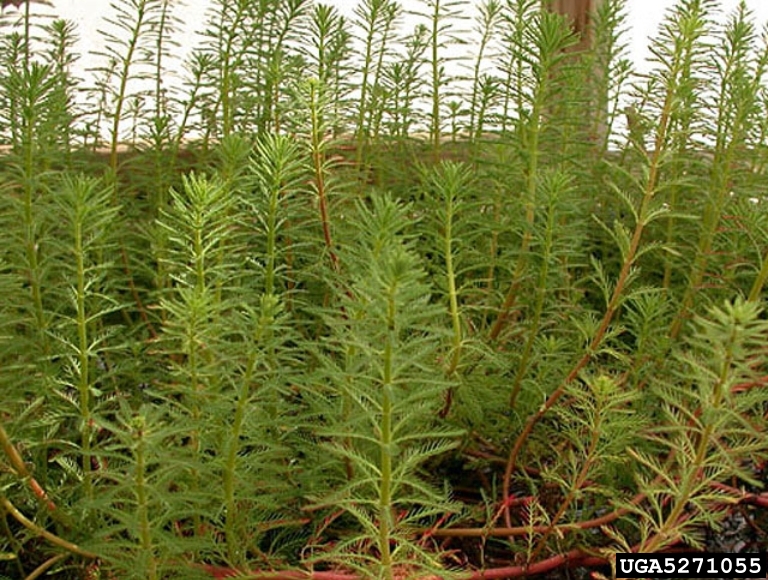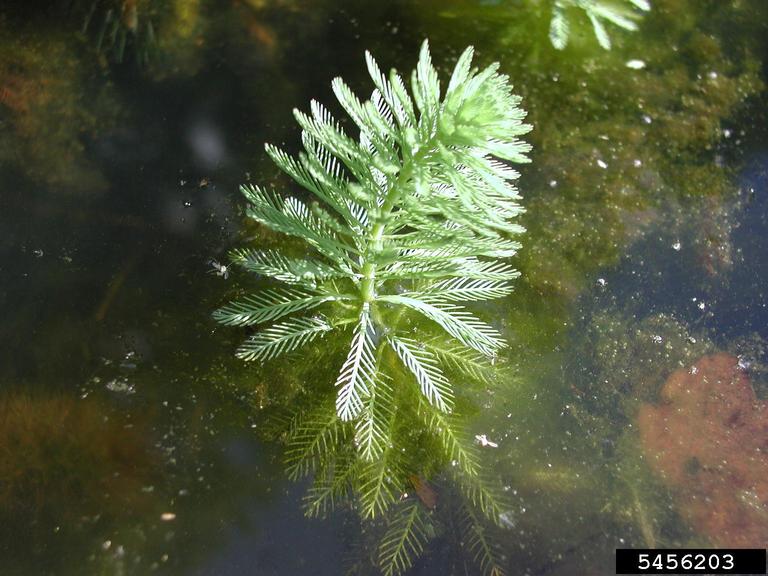Parrot's Feather

Parrot's Feather
(Myriophyllum aquaticum )
Priority: - Contain / Annual Control
Tags: Aquatic
Identification and Reproduction
Identification:
- It is a herbaceous aquatic plant.
- Parrot's feather grows laterally, creeping along the water surface. They resemble tiny trees sticking out of the water and can extend up to 30 cm out of the water surface.
- Stems are made up of short segments and can spread over 1.5 m long.
- The plant's leaves are pinnate (feathery) in a whorl pattern around the stem.
- When leaves are submerged in water they appear reddish-orange, when the leaves stand above water they will take on a greyish-green colour.
Reproduction:
It reproduces vegetatively through stolons. It can easily re-root from displaced plant fragments. Plant pieces as small as 4mm can re-establish and lead to a large infestation.
Habitat & Ecology
- It can be found in slow-moving waterways. This can include wetlands, ditches, or the edges of lakes.
- It prefers slightly alkaline conditions. It grows more aggressively if sunlight can reach the entire plant.
- This plant thrives in freshwater with high nutrient levels.
- Parrot's feather is currently found throughout the Fraser Valley.
Impacts
Social:
- Parrot's feather forms monocultures and blocks waterways, irrigation and drainage systems.
- As it blocks and slows waterflow this increases flood risk.
- Dense parrot's feather mats will limit recreational activity.
Ecological:
- Aggressively invades fresh-water environments
- It disrupts the growth of native aquatic plants, reduces biodiversity, and interferes with fish and wildlife by displacing their natural habitat.
- Dense canopies will limit oxygen and sunlight intake of other vegetation.
- Parrot's feather also can trap sediment and overtime slow the water flow and increase water levels.
- It also creates pools of stagnant water that is a favourable habitat for mosquitos.
Management
Prevention is a high priority for this plant. Always clean, drain, and dry aquatic equipment like boats or canoes before transferring from one body of water to another. Never grow or intentionally transport this plant, or dispose of aquarium plants in waterways or down the drain.
Mechanical/Manual Control:
- Small infestations can be removed by hand or raking up the plants.
- Mechanical removal should be avoided as small fragments can reproduce.
- Since this plant does not colonize terrestrial sites it is safe to compost in a contained area.
Resources
For further details on Parrot's Feather control please refer to the Metro Vancouver Best Management Practices for Parrot's Feather (pg. 11-21)
Download the Metro Vancouver Factsheet on Parrot's Feather here.
Download the Invasive Species Council of BC's Factsheet for Parrots Feather here.
King County is also a good resource for historic and identification information on the parrot's feather.
Header photo (Harry Rose).




